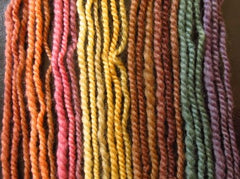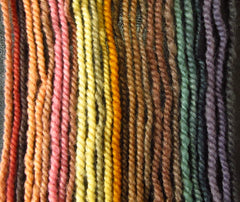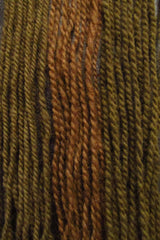 The preliminary Fibershed tests look pretty good! Each color set of three represents a different mushroom or pH treatment. Starting left to right the mushrooms are as follows: Cortinarius semisanguineus; Hypomyces lactifluorum pH 7; H. lactifluorum pH 9; Gymnopilus ventricosus; Phaeolus schweinitzii; Pisolithus sp. (under Eucalyptus) pH 9; Pisolithus arhizus pH 9; Phellodon atratus pH 9; Omphalotus olivascens. The first of the set of three is untreated wool, the second was mordanted with Rhubarb leaves (by Birdsong Sundstrom), and the third was mordanted with Valley Oak galls.
The preliminary Fibershed tests look pretty good! Each color set of three represents a different mushroom or pH treatment. Starting left to right the mushrooms are as follows: Cortinarius semisanguineus; Hypomyces lactifluorum pH 7; H. lactifluorum pH 9; Gymnopilus ventricosus; Phaeolus schweinitzii; Pisolithus sp. (under Eucalyptus) pH 9; Pisolithus arhizus pH 9; Phellodon atratus pH 9; Omphalotus olivascens. The first of the set of three is untreated wool, the second was mordanted with Rhubarb leaves (by Birdsong Sundstrom), and the third was mordanted with Valley Oak galls.
 Here is a comparative photo of the controls with commercial mordants. The mushrooms are the same as the previous photo: Cortinarius semisanguineus; Hypomyces lactifluorum pH 7; H. lactifluorum pH 9; Gymnopilus ventricosus; Phaeolus schweinitzii; Pisolithus sp. (under Eucalyptus) pH 9; Pisolithus arhizus pH 9; Phellodon atratus pH 9; Omphalotus olivascens. The difference is that the first is unmordanted, the second is mordanted with 15% alum and the third is mordanted with 7% iron.
Here is a comparative photo of the controls with commercial mordants. The mushrooms are the same as the previous photo: Cortinarius semisanguineus; Hypomyces lactifluorum pH 7; H. lactifluorum pH 9; Gymnopilus ventricosus; Phaeolus schweinitzii; Pisolithus sp. (under Eucalyptus) pH 9; Pisolithus arhizus pH 9; Phellodon atratus pH 9; Omphalotus olivascens. The difference is that the first is unmordanted, the second is mordanted with 15% alum and the third is mordanted with 7% iron.
Additional tests were done with rust water as an alternative to ferrous sulfate. The iron rich solution was made by soaking a rusty steel wool pad in a jar of water/vinegar for a couple of weeks. It did not turn rust red as I expected, but dissolved into a slate black sludge.
 The yarn on the right was my first tester and simmered for an hour in a half cup of the iron rich solution, diluted with water. After washing the unbound iron solution out of the wool in a mild soapy detergent, it was simmered along with the ferrous sulfate mordanted control (on the right) in a Phaeolus schweinitzii dye bath. Both resulted in a beautiful deep olive-green; a typical reaction to the dye.
The yarn on the right was my first tester and simmered for an hour in a half cup of the iron rich solution, diluted with water. After washing the unbound iron solution out of the wool in a mild soapy detergent, it was simmered along with the ferrous sulfate mordanted control (on the right) in a Phaeolus schweinitzii dye bath. Both resulted in a beautiful deep olive-green; a typical reaction to the dye.
Hailing success, I added a 3oz skein of wool and the rest of my iron solution to a pot of simmering water and repeated the process. This time the results were a rather disappointing brown, as seen in the middle sample. I think that the solution was just too weak to handle the weight of the big skein of wool.
Gauging amounts is going to be a challenge when working with mordant alternatives. And while the brown wool in the middle may be an attractive color, the potential of this mushroom dye is so much more.
Looks like it’s back to the lab for me. I’d love to hear about others experiments with mordant alternatives. Drop me a line at mycopigments@gmail.com or leave a comment if you have had good luck.
